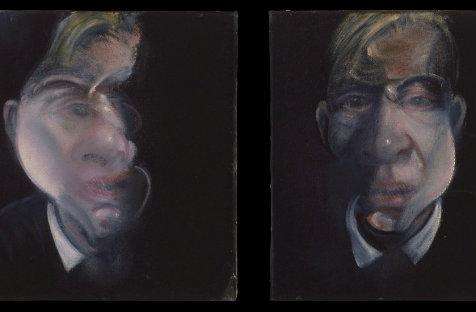The screaming figures, hellish papal thrones, crucifixions, and distorted lovers of British artist Francis Bacon (1909 – 1992) are confronting, inspiring a deep sense of disquiet. Certainly, Bacon’s work is emotionally challenging. This is no accident. Bacon wants to have a direct impact on your nervous system.
Francis Bacon: five decades is the first major exhibition of its kind in Australia, and marks the 20th anniversary of Bacon’s death. It features more than 50 works, gathered from 37 institutions and private lenders, and is supported by numerous photographs, ephemera, and video productions. Considering the high value of his work and the breadth of the exhibition, the effort on the part of Art Gallery of New South Wales in mounting this exhibition is tremendous.
As per the title, the exhibition is organised in a sequence of five decades, progressing from room to room, decade to decade, from the destruction and devastation of the war years in the 1940s through to the more affluent 1980s.
In Head II, a thick impasto is built slowly, over time, creating a relief-like surface within the painting. A sense of movement and direction is pierced into the paint, complete with protruding teeth, and an ear emerging from within the mass: a kind of a birthing process rendered in muted colours.
On another wall, faces move away from gaping mouths and turn into shadowy figures, their changeable forms set within frames and caged boundaries. Some figures are in twos, possibly in a loving embrace, possibly fighting – perhaps evidence of the inspiration Bacon took from the works of Eadweard Muybridge, an English photographer interested in studies of motion; Bacon was said to have observed ‘a slippage of violence and eroticism in Muybridge’s wrestling figures’.
Bacon often employed photographs of his models as an aide in the painting process. He liked being left alone, without the subject’s presence. As part of the exhibition, a number of Bacon’s photographs are on display, folded and creased, in multiple exposures. Elsewhere, the exhibition includes Bacon’s books on Velasquez, Michelangelo, Raphael and Courbet.
Velasquez was known for modifying paint by adding other substances to it, such as glass, creating very specific effects. Progressively through the years, Bacon adds different materials to his paint, such as sand and chalk, to modify the medium’s consistency. He varies the amount of pigment to oil to create a variety of textures: the density and shine of black oily tar, the graininess of asphalt, marrying these with a sensitive and knowing application across the weave of raw canvas.
Over the decades, Bacon’s paintings become progressively more colourful, focusing the subject in the middle of the canvas, with broad sweeping areas of clean beautiful colour. Tenderness and affection becomes more evident, particularly so in Three Studies for Self Portrait.
The paintings in the exhibition are under glass and allow for close inspection and observation. Your reviewer may not be a Bacon devotee entirely; however I have found a new and deep appreciation for his understanding, exploration and application of paint. I have found myself excited and exhilarated by the possibilities and playfulness of it, intrigued by his many and varied means of applying paint to the canvas.
My affection for Bacon is brought on by his Study for a Portrait of Van Gogh IV, in which he depicts Van Gogh as a Van Gogh reaper, utilising an entirely different palette, and an entirely different means of applying paint. In effect, he is reflecting his subject in depiction, as well as the materiality of his paint.
One can never become entirely familiar with an artist’s work by examining reproductions of their work; the trouble with photographs is that they are not paintings. To truly appreciate a painting, one must see it in the flesh.
Francis Bacon: five decades
Art Gallery of New South Wales, Sydney
17 November 2012 – 24 February 2013





